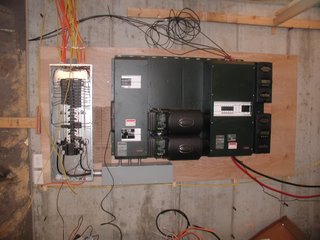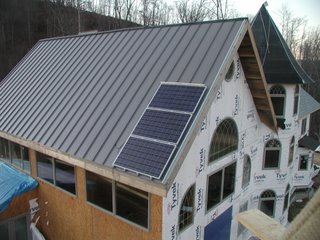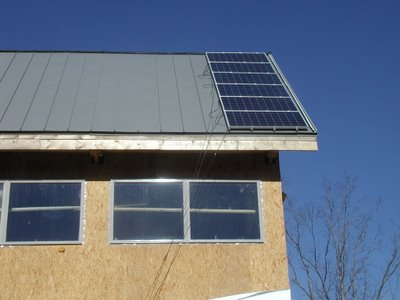The day we turned the generator off...
 Wednesday, with 3 solar panels mounted to the roof, most of the circuits pulled into the main breaker box, and the inverter station wired to the breaker box, I realized that we could test out the entire power center for the house, if only I had the batteries on site and wired. I drove the backhoe to my workshop where the batteries were stored and brought them up to the house site. We wired them in a temporary location in the basement and ran the heavy 0000 ("four ot") gauge cables to the inverter panel. We had been backfeeding the breaker box with a honda generator, so we were careful to disconnect the generator from the "mains." Of course, our flourescent lighting went out as soon as we took the generator down. But then I threw the DC switch that connects the batteries to the "Master" inverter. LEDs flickered, Red, yellow, green, two greens, go! The inverter's cooling fan came on momentarily and then spun back down and everything seemed happy,
Wednesday, with 3 solar panels mounted to the roof, most of the circuits pulled into the main breaker box, and the inverter station wired to the breaker box, I realized that we could test out the entire power center for the house, if only I had the batteries on site and wired. I drove the backhoe to my workshop where the batteries were stored and brought them up to the house site. We wired them in a temporary location in the basement and ran the heavy 0000 ("four ot") gauge cables to the inverter panel. We had been backfeeding the breaker box with a honda generator, so we were careful to disconnect the generator from the "mains." Of course, our flourescent lighting went out as soon as we took the generator down. But then I threw the DC switch that connects the batteries to the "Master" inverter. LEDs flickered, Red, yellow, green, two greens, go! The inverter's cooling fan came on momentarily and then spun back down and everything seemed happy,  so I threw the switch to the second "Slave" inverter. It performed exactly the same dance of lights and fan noises but settled into a blinking green LED state, because it was waiting in standby-mode for the power consuumption to warrant its active participation. Satisfied that everything was happy and dying of anticipation (sorry, I should clarify... the inverters were happy, and I was dying), I threw the switch that connects the inverters to the house's breaker box. The lights came back on! We were running on battery power! Not exactly solar power, but an important first step.
so I threw the switch to the second "Slave" inverter. It performed exactly the same dance of lights and fan noises but settled into a blinking green LED state, because it was waiting in standby-mode for the power consuumption to warrant its active participation. Satisfied that everything was happy and dying of anticipation (sorry, I should clarify... the inverters were happy, and I was dying), I threw the switch that connects the inverters to the house's breaker box. The lights came back on! We were running on battery power! Not exactly solar power, but an important first step.Quickly I ran outside and warmed up the crane. I thought I could temporarily wire the solar panels before it got dark... it wouldn't look pretty but it should work for testing purposes. My bro-in-law flew me up to the roof on the end of the crane and I wired 3 panels in series, made a make-shift strain-relief
 , and dropped the two leads back to the ground. When I got back to the ground, I shut the system back off and wired the solar leads to the MX-60 MPPT. (yes I know, there are supposed to be DC circuit breakers, lightning arrestors, conduit, and a chassis ground in this part of the story, but those will come soon, I promise) Satisfied that I had the polarity correct, I powered the inverters back up, and then turned on the MPPT. It woke up with a fancy display on its lcd screen, but then pronounced it was "snoozing". Snoozing?!?! At a time like this, how could it just sit there and snooze?! I looked outside and saw that the sun had set behind the hills... but surely there was enough light left to keep this thing from snoozing?! I started jumping through the menus on the MX60's display - aha there it was... a way to lower the current threshold so my MX60 wouldn't snooze in low light levels. But the system asked for my password and, defeated but not broken, I decided it was time to RTFM. There it was, on page B.26 the factory default password! By the time I got the password in the system and lower the cut-in threshold, the MX60 declared that it was now "Sleeping!" It was now dark outside... my window of opportunity had passed and I would have to wait one more day to "Go Solar."
, and dropped the two leads back to the ground. When I got back to the ground, I shut the system back off and wired the solar leads to the MX-60 MPPT. (yes I know, there are supposed to be DC circuit breakers, lightning arrestors, conduit, and a chassis ground in this part of the story, but those will come soon, I promise) Satisfied that I had the polarity correct, I powered the inverters back up, and then turned on the MPPT. It woke up with a fancy display on its lcd screen, but then pronounced it was "snoozing". Snoozing?!?! At a time like this, how could it just sit there and snooze?! I looked outside and saw that the sun had set behind the hills... but surely there was enough light left to keep this thing from snoozing?! I started jumping through the menus on the MX60's display - aha there it was... a way to lower the current threshold so my MX60 wouldn't snooze in low light levels. But the system asked for my password and, defeated but not broken, I decided it was time to RTFM. There it was, on page B.26 the factory default password! By the time I got the password in the system and lower the cut-in threshold, the MX60 declared that it was now "Sleeping!" It was now dark outside... my window of opportunity had passed and I would have to wait one more day to "Go Solar."Thursday started out cloudy, and then turned to snowy. With snow accumulating on the panels, it seemed like there was no hope of "going solar." Much to my surprise, the MX60 decided to wake up and started serving 5.... 10.... 15 watts of power to the batteries. Soon, it was reading 200 watts, even with snow on the panels. That did it, I pulled all of the generator wiring from the breaker box and decided that we were now "Solar!" Of course, I got little done that day - I couldn't take my eyes off of the status display on the MX 60. Every 5 minutes, I would run down to the basement and see how many watts we were producing and check our battery voltage. Before the end of the day, we registered a high of 400 watts from the 624 rated-watt panels. In fact, due to meager use of power tools and flourescent lighting, we finished the day with almost as much energy in our batteries as when we started!
 Friday, the sky was clear for much of the day and we produced a whopping 1.7 Kwhrs by 2:00 pm - which was again enough to meet our power needs without ever turning on the generator. Bouyed by the success, and addicted to solar power, I decided to connect 3 more panels for a total of 6. (when in fact, what I really should be doing is working on the permanent installation of all of the panels, or the flashing for that slate roof.) We brought the second set of panels on-line at about 3:45pm - just in time to see 300+ watts from each set of 3 panels.
Friday, the sky was clear for much of the day and we produced a whopping 1.7 Kwhrs by 2:00 pm - which was again enough to meet our power needs without ever turning on the generator. Bouyed by the success, and addicted to solar power, I decided to connect 3 more panels for a total of 6. (when in fact, what I really should be doing is working on the permanent installation of all of the panels, or the flashing for that slate roof.) We brought the second set of panels on-line at about 3:45pm - just in time to see 300+ watts from each set of 3 panels.We didn't work today (Saturday), but I had to visit the house site and see how the panels were performing. Each set of panels was producing approximately 540 watts of power - almost 90% of their best case rating and the 48 volt batteries were at 54 volts! So, even though they're not permanently wired, these panels are permanently mounted. Eventually, I will cover the entire south roof with 48 solar panels, for a total electricity generating capacity of 10,000 watts in the noon sun. But for now I think we have enough electricity to run all of our tools.


7 Comments:
Thomas,
What a cool accomplishment. Your excitement is tangible. In fact, I am now intrigued to the point that I want to look into this option for my barn/shop that I plan to build up in our pasture. I had planned on using generator power for everythiong. Now I am thinking that I could use the genset for heavy equipment (compressors, welders, etc.), but solar power for lighting and running circ pumps for heating (propane fired).
Cool stuff. Congratulations.
Jim K
It _is_ exciting. We're currently living "on the grid" in a double-wide and although we're only 1 mile from the house site, it feels like we're living a full century away from our new house. I've had a flu bug or something recently and unable to work on the house, and it's killing me not to be up there using that solar electricity. Ironically, I've planned to use 100% flourescent lighting in our new house, but now that we have "Free" (well, not really free - the upfront costs are astronomical, but the marginal cost is free) electricty going to waste when the batteries are full, I've invested in a 500 Watt halogen work light to consume some of that energy! (you know, one of those lights that heats your body like a rotisseree chicken under the heat lamps at Krogers?!)
The solar electric system for our house is intentionally over-designed. A scaled down version would be perfect for a workshop (or even for a house without air conditioning). I'd say go for it. The inverters have a feature to kick on the generator seamlessly when the power consumption warrants it. I'll let you know whatever I can learn from this system. So far, I'm really impressed with the level of engineering and thought that has gone into the inverters, etc. But its definitely not "mainstream" yet. Even the simplest thing like "where to bond the earth ground?" on the system is not spelled out clearly. Oh well, I'll figure it out or find someone who can tell me!
It will be another 3-5 years before I do that barn, but that will give me time to do my homework. I will definatley look for more input from you as you live and work with your system.
I hope you feel better soon. My project work has slowed to a crawl with the holidays, kids activities and weather. I did successfully wire my first 4-way lighting circuit in about an hour last night!
wow!! done well. Almost Free Electricity :) Love to do it but at this stage the upfront cost me too much. How much did it cost you in total.
Honda generator parts
This particular blog entry is giving me hope that even a small, six panel or less set up, could power a small workshop starting out. I know our future house will need more power plus power storage capacity though I think starting with a smaller set up to test ideas and run the workshop for on site storage and workspace will be my first step.
While I have read that both you and a few posters us fluorescent lighting off grid, have any of you considered moving over to LED light technology? Doing basic calculations I found that swapping over just from CFL/conventional fluorescent bulbs to LEDs would reduce our current on grid home power consumption, for lighting only, by over 97 percent.
I figured I would pass that along as an idea. It might even allow you to have more lights for the same consumption or allow you to run longer from batteries before needing a generator to recharge them.
Book Hunter,
A couple of years ago, we experimented with LED lighting where we live now (a mobile home on the grid), and decided that LEDs (c. 2007) were where CFLs were about 10 years ago (c. 1997). Pricey, unreliable, and not the best color. But look how far CFLs came in a decade. I'd say in 5 or 10 years, I'll be replacing the CFL's with LEDs as the CFLs burn out. Right now, lighting makes up just a fraction of our power usage at the house site. The fridge and freezer collectively use about 2Kwhrs/day. The computers use even more when we leave them on! Every little bit counts though - especially since the lights are usually on when the sun is down. Let me know if you find a brand/model of LED bulb that you're happy with - I'll try one.
Great blog, great home.
I am still reading through, but the question that comes ot mind right now concerns your choice to go with roof mounted solar panels` as opposed to a tall free standing array located near the home. Do you prefer the roof mount over free standing or is there some data that says roof mount is in some way better?
Post a Comment
<< Home